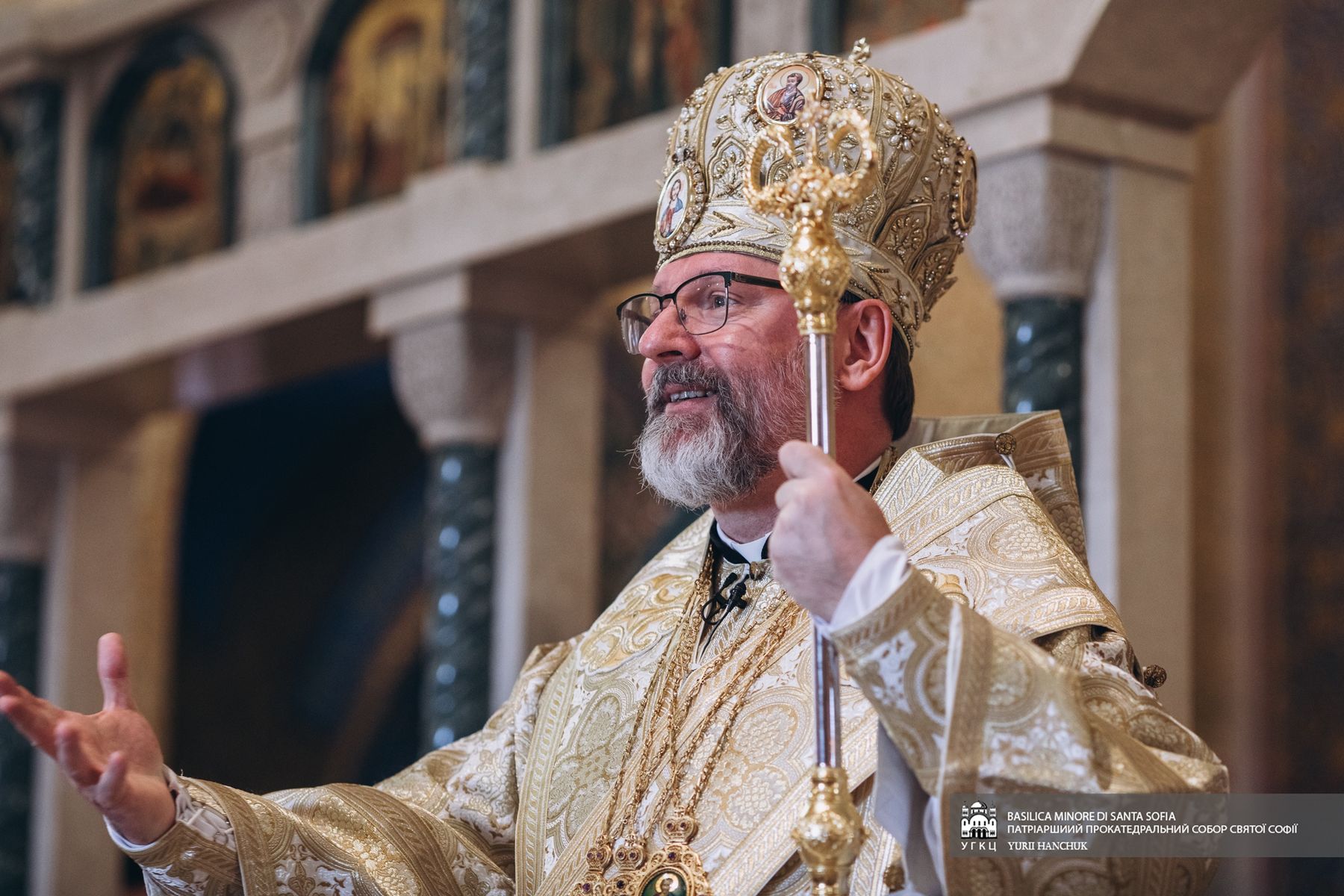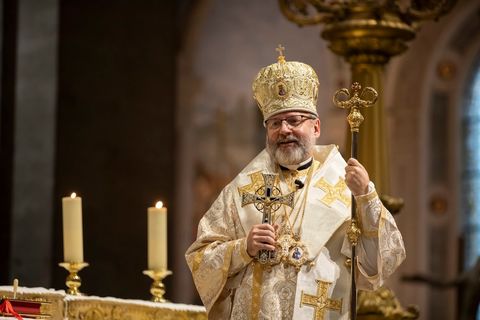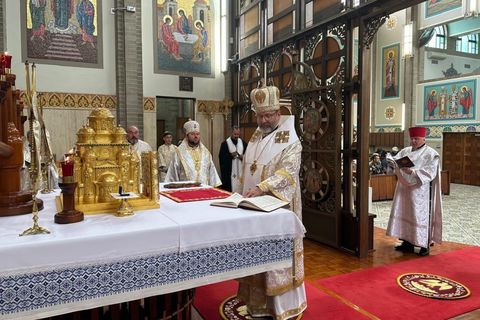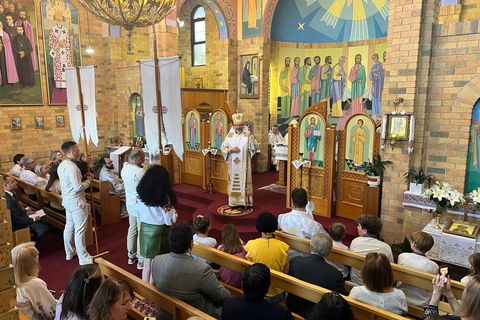
Homily of His Beatitude Sviatoslav on St. Thomas Sunday in Rome
Jesus enters, stands in the middle
and he says to them, “Peace be with you!” (Jn 20:19).
Your Graces Borys and Mykola!
Reverend Sisters!
Venerable Fathers!
Dear brothers and sisters in Christ!
Our esteemed Roman community, parishioners
Of the historic Basilica of St. Sophia in Rome!
Christ is risen!
Today, the eighth day after Easter, we celebrate a special event — the feast of the presence of the risen Christ among his disciples. The Gospel of John (Jn 20:19–31), appointed today, and as we listen to it for our spiritual nourishment we hear of two events. The part of the Gospel text that describes the first event refers to Sunday evening on Easter itself, and it is read on Eastern Sunday at Vespers. The other part describes the events of the following Sunday — the one we are experiencing today.
If we listen carefully to God’s word, we will discover an important point. Ordinarily, this Sunday focuses on the Apostle Thomas. At first, he was absent, and later he was present. At first, he did not believe, and then he believed. However, I invite you now to look at God’s word with different eyes and listen to it with an openness, a spiritual way of listening. The figure of the apostle is only part of a broader description of the double manifestation of the risen Jesus among the apostles. We know that when something is repeated in the Holy Scriptures — a word or a gesture — this is the main focus of this text. Today we hear Christ say to his disciples three times: “Peace be with you!” It is in these words that we have the source from which everything else flows.
Scholars of this scriptural text note that John most likely conveys it as a description of the apostolic Liturgy. The same gesture is described twice: Christ stands in the midst of the disciples and says: “Peace be with you!” As we know, all the Liturgies of the Churches of the apostolic tradition contain this gesture and begin with these words. Those who pay attention to our Liturgy can count how many times a priest, blessing the faithful, exclaims: “Peace to all!” What does this expression mean?
These words belong to the genre of a greeting. “Shalom” (“peace”) is still a familiar way to greet a person in Israel. However, the risen Christ, coming to the disciples through locked doors, gives these words a deeper meaning. Shalom, peace is the very breath of the risen Savior. Christ does not just wish for peace, as people wish a good day when greeting, he does not simply speak of peace, but He himself is peace (cf. Eph. 2:12–22). He transmits this peace to his disciples!
The peace that Christ gives after the resurrection signifies the fullness of human life in the resurrection. Only the person who has completed his earthly journey in God, who has fully understood this inspiration, who breathes eternal life in the resurrection to the fullest, is at peace.
Praying for the departed, we ask the Lord God to rest them in his peace, in his rest. Christ breathes this peace. Moreover, He sends His disciples to carry this peace further. The ability to breathe in a human breath of the Risen One signifies the apostolic tradition of Christ’s Church. The Savior says this to His disciples today: “Peace be with you! As the Father has sent me, so I send you.” Having said this, he breathed on them and said to them, ‘Receive the Holy Spirit!’” (Jn 20:20–22).
Therefore, whenever you receive, in the context of the Liturgy, the blessing of this peace, or when you ask for a blessing from a priest or bishop, your Church breathes upon you the breath of the risen Savior. And this breath brings to people of all times and places the long-awaited peace that comes only from God. Christ says, “Peace I leave with you, My peace I give to you; not as the world gives, I give it to you” (Jn 14:27). For such peace of the Risen One does not exist anywhere in the world, among people.
Let us also look at the figure of the apostle. Listening to the story, the testimony, the good news that Christ was resurrected, we see that Thomas does not believe and cannot get peace. He is overwhelmed by fear because he has lost everything. Having experienced the terrible drama of the crucifixion and death of his Savior, the apostle does not believe that there can be anything else. Like the people of his time, he understood that death was the end, after which there was nothing but the kingdom of darkness. In order to believe that peace from God was true and could be obtained, Thomas had to see the resurrected Savior, meet and touch Him. To see here is to believe.
Sometimes we are surprised when we meet a person with whom we have not seen each other for a long time: “I don’t recognize you, you have changed so much!” Something similar was going on in the soul and heart of that student. He could say: Teacher, I do not recognize You, because You have changed — for He suffered, died and rose again, has wounds on His body. Here, to recognize the risen Christ meant to be converted, to stop believing in one’s own ideas about Him. To believe is not so much to agree to someone else’s fiction or illusory reality as to be able to see reality as it is today. To believe is to touch the Risen One, to accept the peace that He wants to give us.
And so today, in these moments, as then in Jerusalem, the risen Christ comes to you. He sent us, your bishops and priests, to be His visible, living icon. The entire apostolic tradition passed down that we have as successors of the apostles is nothing more than the ability to breathe the same spirit of Christ’s resurrection upon you in order to impart His peace to you. And now you only need to believe that this peace is real and say like an apostle: “My Lord and my God!” (Jn. 20:28). Then together we can become bearers and builders of the peace we seek in our world of war, death and suffering. For centuries, the Fathers and Teachers of the Church of the West and East have taught that peace does not come from compromises or agreements that prevent people from living with dignity, developing and feeling justice for themselves. Such agreements, on the contrary, will lead to new wars. Only when a person opens up to the possibility for himself and other people to live fully, to realize themselves in the peace of Christ and to comprehend the fullness of life in God, will the “times of peace” for which we pray in the Divine Liturgy come.
Dear ones in Christ, we are all affected by yesterday’s event. We experienced the funeral of Pope Francis. There, in St. Peter’s Square, where the whole world gathered, we felt that the risen Christ came to us and said to us: “Peace be with you!” — we felt that He breathed the spirit of resurrection even on the late Pope. We commended the Holy Father Francis into the hands of our resurrected Savior. Even the hymns of the Latin Church that we sang yesterday was a prayer: “That I may see God in my body” (“Et in carne mea videbo Deum salvatorem meum”. Responsorium CREDO QUOD REDEMPTOR MEUM VIVIT). We have given Pope Francis to life and resurrection.
Yesterday another important event took place, which everyone is talking about now. The community — to which the risen Christ came and said: “Peace be with you!” — was joined by hundreds of thousands of people who came to the funeral from all over the world. At the Liturgy, three presidents sat directly opposite me: America, France and Ukraine. It was something unique to see them together in person during the liturgy. As you know, before going to St. Peter’s Square, they had a meeting and talked about peace in Ukraine. I looked at them and prayed that their hearts would turn to God and to Ukraine, that they would experience the same as the Apostle Thomas, that they would believe that the peace that is talked about so much is possible and that Christ wants to give them in the presence of the late Pope, the entire Universal Church and the people of God.
Today we ask: Jesus, come to us. You, the Risen One, have called us today in Kyiv, Donetsk, Zaporizhzhia, Kharkiv, Odessa — in the midst of the kingdom of death that Russia is creating — to breathe Your spirit onto that land. You send us — those who believe that You have risen from the dead — to that land so that we can say to our soldiers, the relatives of the dead, and even those who are being punished in captivity today: “Peace be with you!” Now there are many closed borders, prisons, torture chambers, and a lot of fear in the world. But Christ also comes there through locked doors. Lord Jesus, come to us, breathe Your peace upon us, blessing our long-suffering Ukraine with it.
A special period begins this Sunday. According to the custom of the Church of Rome, the Novena begins — a nine-day prayer — for the late Pope Francis, which precedes the Conclave of Cardinals. I call on our entire Church to accompany the Church of Rome in her prayer for the late Holy Father. At the same time, I ask you to pray for the cardinals, to whom the Lord will entrust a special responsibility (and not just dignity!) — to discern at the Conclave who should be the successor of the Apostle Peter, and to make a choice according to the voice of their conscience, looking at the glorious fresco of the Last Judgment in the Sistine Chapel.
Today, here in Sobor of St. Sophia, there is an icon of our global Church. I came here as a witness from Kyiv. Metropolitan Borys arrived from Philadelphia. There is also a young bishop Nicholas from Australia, who, as a cardinal of the Church of Rome, will participate in the Conclave. Pray for Bishop Mykola and for all those who will fulfill the difficult duty of being a herald of peace for Rome, Ukraine and the world. We must all recognize together by our faith the risen Savior present among us and, like Thomas, say, “Nothing else and no one else, only You, Jesus are my Lord and God.” Amen.
Christ is risen!
† SVIATOSLAV



